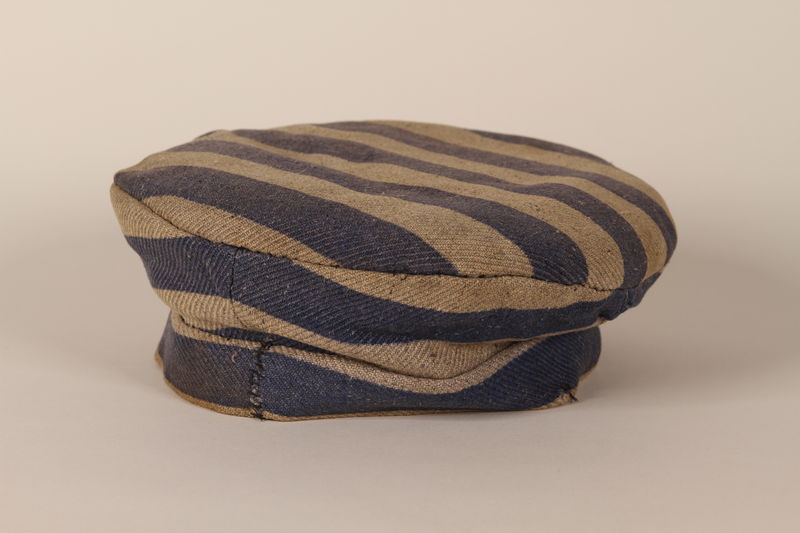Overview
- Brief Narrative
- Striped uniform cap issued to Erich Sakofski (later Harvey Shreibman) while he was imprisoned at Flossenbürg concentration camp between February and March 1945. Erich was living in Pruzana, Poland (now Pruz︠h︡any, Belarus), with his parents, Nachum and Rachel, and his older brother, Avrum, when Poland was invaded by Germany and the Soviet Union in September 1939. Pruzana came under Soviet control with authorities shuttering all Jewish institutions and quickly closing or nationalizing all businesses, including Nachum’s. On June 22, 1941, Germany invaded Soviet-occupied Poland, and by September, all Jews in Pruzana were living within a closed ghetto. In late January 1943, the Jews of Pruzana were deported for collaborating with partisans. Avrum hid during the deportation, hoping to join the resistance afterwards, but likely perished. Erich and his parents were transported to Auschwitz-Birkenau killing center. Erich was selected for work details, while his parents were likely sent to the gas chambers. After six weeks in quarantine, Erich was transferred to the main Auschwitz camp and moved to Auschwitz-Monowitz (Buna) in March 1944. In January 1945, as Soviet forces advanced on the region, all Auschwitz camps were evacuated. Erich was deported to three concentration camps in Germany: Sachsenhausen, Flossenbürg, and Platting before being liberated by US forces during a forced march on May 2, 1945. Following the war, Erich lived at Weilheim and Prien am Chiemsee displaced persons (DP) camps in Germany. On December 14, 1947, Erich sailed to the United States aboard the SS Marine Tiger.
- Date
-
issue:
1945 February-1945 March
- Geography
-
issue:
Flossenbürg (Concentration camp);
Flossenbürg (Germany)
- Credit Line
- United States Holocaust Memorial Museum Collection, Gift of Harvey Shreibman
- Contributor
-
Subject:
Harvey E. Shreibman
- Biography
-
Erich Sakofski (later Harvey Shreibman, 1925-2007) was born in Pruzana, Poland (now Pruz︠h︡any, Belarus) to Nachum Dawid (1895-1943) and Rachel Ross (1897-1943) Sakofski. He had one older brother, Avrum. Nachum ran a leather business selling raw materials to shoemakers. Nachum was very devout, and attended services at the synagogue three times a day. While at services, Rachel would mind the store, and sometimes Erich would help. Avrum had completed his studies at the local Gymnasium, or public secondary school, while Erich attended school at the local Yeshiva, an Orthodox Jewish secondary school.
On September 1, 1939, Germany invaded western Poland, and in mid-September, the Soviet Union occupied eastern Poland in accordance with the Molotov-Ribbentrop Pact. Pruzana fell under Soviet control, and all private businesses were banned. This forced all of the Jewish merchants and shopkeepers, as well as cultural and religious institutions, to close. Soviet authorities seized and nationalized Nachum’s store, and marked his passport to indicate that he was a businessman, which severely lowered his social status. There were very few jobs for Jewish people, and Nachum would have received the worst possible position that required him to work on the Sabbath, a sacred practice he was not willing to break. This decision left him with no income, and had a large impact on the family. Several times that fall, members of the Soviet security forces invaded the Sakofski family’s home in order to call Nachum a parasite for depending on others for his livelihood.
Erich’s school was shut down after the invasion, and he was required to attend the Soviet public school and sit through many lectures centered on Soviet indoctrination. The Soviet authorities established a teacher-training course, which Avrum successfully completed and quickly found a post in a neighboring town that helped support his family. In 1940, security forces dug up the family’s yard on the pretense of looking for a cache of black market goods. Although innocent, Nachum was arrested and imprisoned nearby, and the authorities banned the family from helping him. After several weeks, a well-connected relative facilitated his release and Nachum returned home very sick and terrified.
On June 22, 1941, German forces invaded the Soviet Union, and entered Pruzana five days later. In September, German authorities ordered the establishment of a closed ghetto in Pruzana. Erich’s family already lived in the enclosed area, but they had to share their home with many people who had been forced to move there. Conditions in the ghetto were crowded and dirty, with very little food, no medicine, and many diseases. To ensure their people were viewed as useful, the Judenrat volunteered to have the Jews in the ghetto make boots and other supplies for the German military.
In the second half of 1942, an underground resistance formed in the ghetto and began working with partisan groups outside. On January 27, 1943, two partisans approached the Judenrat in the hopes of strengthening their association. The German authorities found out, and charged the Judenrat with collaboration. The following day, the authorities began loading Pruzana’s Jews onto transport trains. Erich’s brother, Avrum, decided to hide in a bunker so he could join the resistance. Erich stayed with his parents so that he could help them if they were sent to a labor camp. Erich, his parents, and an uncle were forced onto crowded train cars, and Rachel was separated from them. After three days and nights with no food or water, the train arrived at Auschwitz-Birkenau killing center. When he got off the train, Erich saw his mother and ran over to see her. They were quickly forced apart, and Erich returned to his father in the men’s group. Erich was selected for one group, and his father was placed in another, then loaded onto trucks. Erich’s parents and uncle were likely gassed.
While his group waited to take showers, Erich asked one of the uniformed prisoners when they would see their families. After a short pause, the man pointed to a nearby smokestack and explained that the smoke was their families. After showering, Erich was issued a striped uniform, but kept his own boots because the guards ran out of wooden-soled shoes. The following day, Erich’s group was marched to the “Gypsy camp,” and quarantined for six weeks. During this time, Erich and the others were often subjected to random beatings and other brutal treatment. The group was then marched to Auschwitz, and assigned to skilled work groups. Initially, Erich claimed to be a shoemaker, but later admitted that he had only been an assistant. The guards allowed him to stay in the group and gave him a simpler task.
In March 1944, Erich was transferred to Auschwitz-Monowitz (Buna) and placed on a coal-shoveling work crew. This was difficult work, and Erich knew he would not survive long. Erich’s kapo introduced him to one of the men who controlled the group assignments, who was also from Pruzana. The man helped Erich to switch his assignment to a painting group where his cousin worked. In mid-January 1945, as Soviet forces advanced on the region, all three Auschwitz camps were evacuated. Erich was deported to a series of concentration camps in Germany, including Sachsenhausen, Flossenbürg, and the subcamp, Platting. On April 25, the subcamp was evacuated and the prisoners sent on a forced march. Erich’s group was liberated by the U.S. Army on May 2, near Traunstein. Five days later, Germany surrendered.
After the war, Erich began to list himself as being five years younger than his actual age. From June 25, 1945 to March 1, 1947, Erich was at Weilheim displaced persons (DP) camp in Germany. By June 30, 1947, Erich was living at the Children’s DP camp at Prien am Chiemsee. Erich’s brother likely perished in the Holocaust. On December 14, Erich boarded the SS Marine Tiger in Bremen and sailed to the United States, where he lived with an aunt and uncle. He later changed his name to Harvey Erich Shreibman. In 1953, Harvey married Thelma Bucknoff (1929-1988) in New York City. The couple had two children and settled in Philadelphia, Pennsylvania, where he owned and operated Harvey’s Men’s and Boy’s Apparel. Harvey regularly participated in synagogue activities, and served in the US Army Reserves during the 1950s. In February 1993, Harvey married his second wife, Rachel Goldfrad (1938 – 2001).
Physical Details
- Classification
-
Clothing and Dress
- Category
-
Concentration camp uniforms
- Object Type
-
Caps (Headgear) (lcsh)
- Genre/Form
- Prison uniforms.
- Physical Description
- Blue and gray, striped, mediumweight, twill weave cloth cap. The blue stripes are printed on the gray cloth, and the hidden seams are machine-stitched. The crown is flat, circular, and slightly padded, as though filled with several layers of interfacing. The sides are formed from four rectangular panels sewn into a band, and attached to the edge of the crown to give the cap height and shape. The stripes on these panels are horizontally oriented and precisely aligned along the seams. A headband, roughly one stripe in height, has been stitched along the bottom edge of the side panels with black thread. The interior is lined with several pieces of gray, satin weave cloth that has been handstitched with black and off-white thread. The hatband has been altered to reduce the band size by gathering the fabric, tucking it in on itself, and sewing it in place with black thread along the interior seams. The lining is discolored and dirty, especially around the headband. The altered seams are pulling loose on the exterior and interior.
- Dimensions
- overall: Height: 3.500 inches (8.89 cm) | Width: 8.625 inches (21.908 cm) | Depth: 8.875 inches (22.543 cm)
- Materials
- overall : cloth, thread
Rights & Restrictions
- Conditions on Access
- No restrictions on access
- Conditions on Use
- No restrictions on use
Keywords & Subjects
Administrative Notes
- Legal Status
- Permanent Collection
- Provenance
- The cap was donated to the United States Holocaust Memorial Museum in 1996 by Harvey Shreibman.
- Funding Note
- The cataloging of this artifact has been supported by a grant from the Conference on Jewish Material Claims Against Germany.
- Record last modified:
- 2023-06-02 08:46:26
- This page:
- https://collections.ushmm.org/search/catalog/irn11664
Download & Licensing
In-Person Research
- By Appointment
- Request 21 Days in Advance of Visit
- Plan a Research Visit
- Request to See This Object
Contact Us
Also in Harvey Shreibman collection
The collection consists of a concentration camp uniform cap, coat, jacket, trousers, and a mug relating to the experiences of Erich Hershel Sakofski (later Harvey Shreibman) as a prisoner in several concentration camps in German-occupied Poland and Germany during the Holocaust.
Date: 1942-1945 April
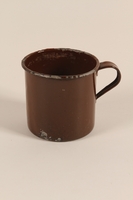
Brown enamel mug used by a Polish Jewish concentration camp prisoner
Object
Enamel-covered mug issued to Erich Sakofski (later Harvey Shreibman) while he was imprisoned at all three Auschwitz concentration camps between January 1943 and January 1945. Erich was living in Pruzana, Poland (now Pruz︠h︡any, Belarus), with his parents, Nachum and Rachel, and his older brother, Avrum, when Poland was invaded by Germany and the Soviet Union in September 1939. Pruzana came under Soviet control with authorities shuttering all Jewish institutions and quickly closing or nationalizing all businesses, including Nachum’s. On June 22, 1941, Germany invaded Soviet-occupied Poland, and by September, all Jews in Pruzana were living within a closed ghetto. In late January 1943, the Jews of Pruzana were deported for collaborating with partisans. Avrum hid during the deportation, hoping to join the resistance afterwards, but likely perished. Erich and his parents were transported to Auschwitz-Birkenau killing center. Erich was selected for work details, while his parents were likely sent to the gas chambers. After six weeks in quarantine, Erich was transferred to the main Auschwitz camp and moved to Auschwitz-Monowitz (Buna) in March 1944. In January 1945, as Soviet forces advanced on the region, all Auschwitz camps were evacuated. Erich was deported to three concentration camps in Germany: Sachsenhausen, Flossenbürg, and Platting before being liberated by US forces during a forced march on May 2, 1945. Following the war, Erich lived at Weilheim and Prien am Chiemsee displaced persons (DP) camps in Germany. On December 14, 1947, Erich sailed to the United States aboard the SS Marine Tiger.
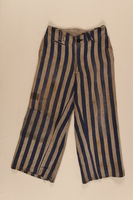
Concentration camp uniform pants worn by a Polish Jewish prisoner
Object
Striped uniform pants issued to Erich Sakofski (later Harvey Shreibman) while he was imprisoned at Flossenbürg concentration camp between February and March 1945. Erich was living in Pruzana, Poland (now Pruz︠h︡any, Belarus), with his parents, Nachum and Rachel, and his older brother, Avrum, when Poland was invaded by Germany and the Soviet Union in September 1939. Pruzana came under Soviet control with authorities shuttering all Jewish institutions and quickly closing or nationalizing all businesses, including Nachum’s. On June 22, 1941, Germany invaded Soviet-occupied Poland, and by September, all Jews in Pruzana were living within a closed ghetto. In late January 1943, the Jews of Pruzana were deported for collaborating with partisans. Avrum hid during the deportation, hoping to join the resistance afterwards, but likely perished. Erich and his parents were transported to Auschwitz-Birkenau killing center. Erich was selected for work details, while his parents were likely sent to the gas chambers. After six weeks in quarantine, Erich was transferred to the main Auschwitz camp and moved to Auschwitz-Monowitz (Buna) in March 1944. In January 1945, as Soviet forces advanced on the region, all Auschwitz camps were evacuated. Erich was deported to three concentration camps in Germany: Sachsenhausen, Flossenbürg, and Platting before being liberated by US forces during a forced march on May 2, 1945. Following the war, Erich lived at Weilheim and Prien am Chiemsee displaced persons (DP) camps in Germany. On December 14, 1947, Erich sailed to the United States aboard the SS Marine Tiger.
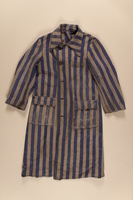
Concentration camp uniform coat worn by a Polish Jewish prisoner
Object
Striped uniform coat issued to Erich Sakofski (later Harvey Shreibman) while he was imprisoned at Flossenbürg concentration camp between February and March 1945. Erich was living in Pruzana, Poland (now Pruz︠h︡any, Belarus), with his parents, Nachum and Rachel, and his older brother, Avrum, when Poland was invaded by Germany and the Soviet Union in September 1939. Pruzana came under Soviet control with authorities shuttering all Jewish institutions and quickly closing or nationalizing all businesses, including Nachum’s. On June 22, 1941, Germany invaded Soviet-occupied Poland, and by September, all Jews in Pruzana were living within a closed ghetto. In late January 1943, the Jews of Pruzana were deported for collaborating with partisans. Avrum hid during the deportation, hoping to join the resistance afterwards, but likely perished. Erich and his parents were transported to Auschwitz-Birkenau killing center. Erich was selected for work details, while his parents were likely sent to the gas chambers. After six weeks in quarantine, Erich was transferred to the main Auschwitz camp and moved to Auschwitz-Monowitz (Buna) in March 1944. In January 1945, as Soviet forces advanced on the region, all Auschwitz camps were evacuated. Erich was deported to three concentration camps in Germany: Sachsenhausen, Flossenbürg, and Platting before being liberated by US forces during a forced march on May 2, 1945. Following the war, Erich lived at Weilheim and Prien am Chiemsee displaced persons (DP) camps in Germany. On December 14, 1947, Erich sailed to the United States aboard the SS Marine Tiger.
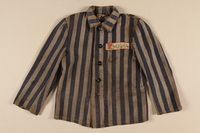
Concentration camp uniform jacket worn by a Polish Jewish prisoner
Object
Striped uniform jacket with prisoner patch P46984 issued to Erich Sakofski (later Harvey Shreibman) while he was imprisoned at Flossenbürg concentration camp between February and March 1945. Erich was living in Pruzana, Poland (now Pruz︠h︡any, Belarus), with his parents, Nachum and Rachel, and his older brother, Avrum, when Poland was invaded by Germany and the Soviet Union in September 1939. Pruzana came under Soviet control with authorities shuttering all Jewish institutions and quickly closing or nationalizing all businesses, including Nachum’s. On June 22, 1941, Germany invaded Soviet-occupied Poland, and by September, all Jews in Pruzana were living within a closed ghetto. In late January 1943, the Jews of Pruzana were deported for collaborating with partisans. Avrum hid during the deportation, hoping to join the resistance afterwards, but likely perished. Erich and his parents were transported to Auschwitz-Birkenau killing center. Erich was selected for work details, while his parents were likely sent to the gas chambers. After six weeks in quarantine, Erich was transferred to the main Auschwitz camp and moved to Auschwitz-Monowitz (Buna) in March 1944. In January 1945, as Soviet forces advanced on the region, all Auschwitz camps were evacuated. Erich was deported to three concentration camps in Germany: Sachsenhausen, Flossenbürg, and Platting before being liberated by US forces during a forced march on May 2, 1945. Following the war, Erich lived at Weilheim and Prien am Chiemsee displaced persons (DP) camps in Germany. On December 14, 1947, Erich sailed to the United States aboard the SS Marine Tiger.

